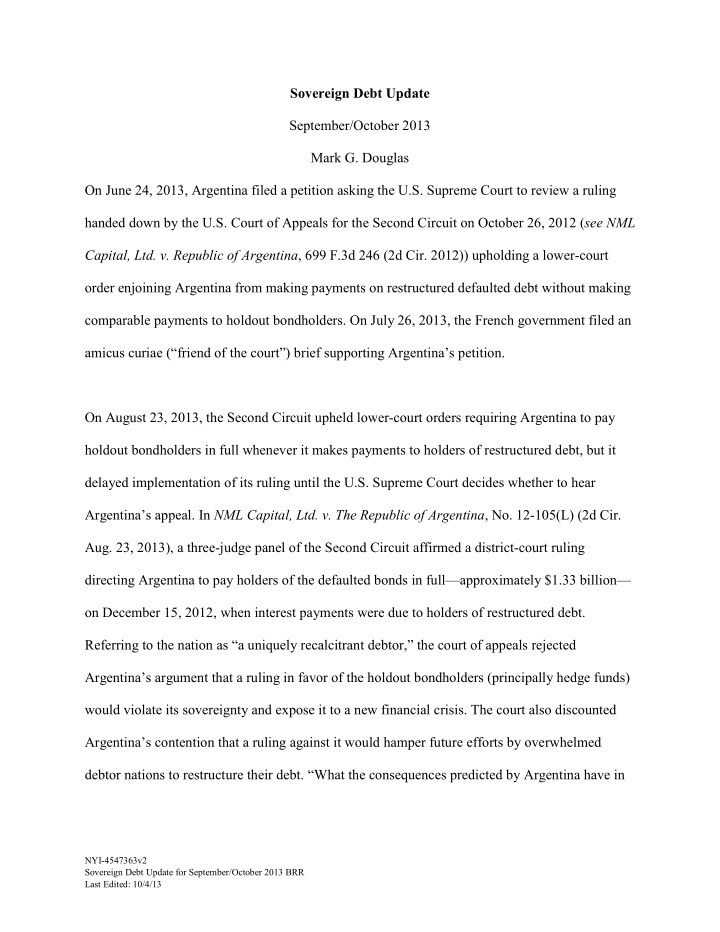



Sovereign Debt Update September/October 2013 Mark G. Douglas On June 24, 2013, Argentina filed a petition asking the U.S. Supreme Court to review a ruling handed down by the U.S. Court of Appeals for the Second Circuit on October 26, 2012 ( see NML Capital, Ltd. v. Republic of Argentina , 699 F.3d 246 (2d Cir. 2012)) upholding a lower-court order enjoining Argentina from making payments on restructured defaulted debt without making comparable payments to holdout bondholders. On July 26, 2013, the French government filed an amicus curiae (“friend of the court”) brief supporting Argentina’s petition. On August 23, 2013, the Second Circuit upheld lower-court orders requiring Argentina to pay holdout bondholders in full whenever it makes payments to holders of restructured debt, but it delayed implementation of its ruling until the U.S. Supreme Court decides whether to hear Argentina’s appeal. In NML Capital, Ltd. v. The Republic of Argentina , No. 12-105(L) (2d Cir. Aug. 23, 2013), a three-judge panel of the Second Circuit affirmed a district-court ruling directing Argentina to pay holders of the defaulted bonds in full—approximately $1.33 billion— on December 15, 2012, when interest payments were due to holders of restructured debt. Referring to the nation as “a uniquely recalcitrant debtor,” the court of appeals rejected Argentina’s argument that a ruling in favor of the holdout bondholders (principally hedge funds) would violate its sovereignty and expose it to a new financial crisis. The court also discounted Argentina’s contention that a ruling against it would hamper future efforts by overwhelmed debtor nations to restructure their debt. “What the consequences predicted by Argentina have in NYI-4547363v2 Sovereign Debt Update for September/October 2013 BRR Last Edited: 10/4/13
common,” the court wrote, “is that they are speculative, hyperbolic and almost entirely of the Republic’s own making.” On September 11, 2013, Argentina’s Congress approved an open-ended bond-swap offer that would allow holders of the remaining seven percent of bonds still outstanding after the country’s 2002 default (as well as participating bondholders) to swap their instruments for new bonds governed by Argentine law. This latest exchange offer follows years of lawsuits stemming from this debt crisis, which has lasted more than a decade. The terms of the swap are a reiteration of Argentina’s 2010 restructuring offer. In that and a previous 2005 debt exchange, 93 percent of holders swapped their defaulted bonds for new paper offering less than 30 cents on the dollar. The U.S. Supreme Court also announced on September 11 that it would convene a preliminary hearing on September 30, 2013, to consider whether it will decide to hear Argentina’s appeal. However, the court took no action on the appeal at the September 30 conference. On October 3, 2013, the U.S. District Court for the Southern District of New York barred Argentina from proceeding with the plan to exchange restructured bonds for debt instruments governed by Argentine law. U.S. District Judge Thomas Griesa ruled that the plan is “an apparent attempt to evade” his previous orders barring Argentina from paying holders of debt restructured in 2005 and 2010 without also paying in full holdout bondholders holding $1.5 billion in defaulted bonds. Judge Griesa reiterated his March 5, 2012 order barring Argentina NYI-4547363v2 Sovereign Debt Update for September/October 2013 BRR Last Edited: 10/4/13
from “altering or amending the processes or specific transfer mechanisms by which it makes payments on the exchange bonds, without prior approval of the court.” NYI-4547363v2 Sovereign Debt Update for September/October 2013 BRR Last Edited: 10/4/13
Recommend
More recommend